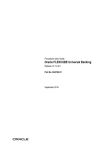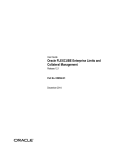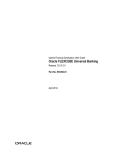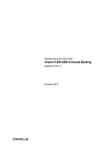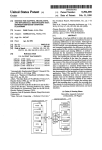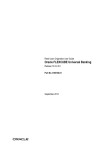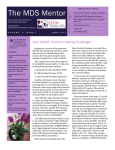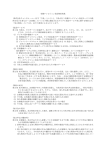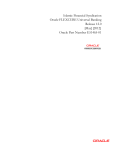Download Oracle FLEXCUBE Universal Banking
Transcript
Oracle FLEXCUBE Universal Banking - FLEXCUBE Core Integration Oracle FLEXCUBE Universal Banking Release 11.5.0.0.0 [July] [2014] 1-1 Oracle FLEXCUBE Universal Banking - FLEXCUBE Core Integration Table of Contents 1. ABOUT THIS MANUAL................................................................................................................................ 1-1 1.1 1.2 1.3 1.4 1.5 1.6 2. INTRODUCTION ........................................................................................................................................... 1-1 AUDIENCE .................................................................................................................................................. 1-1 ORGANIZATION .......................................................................................................................................... 1-1 CONVENTIONS USED IN THIS MANUAL ....................................................................................................... 1-1 GLOSSARY OF ICONS .................................................................................................................................. 1-1 RELATED DOCUMENTS ............................................................................................................................... 1-2 INTEGRATION PROCESS ........................................................................................................................... 2-1 2.1 COMMON BATCH FRAMEWORK .................................................................................................................. 2-1 2.2 LEAD BASED ORIGINATION ........................................................................................................................ 2-1 2.3 DYNAMIC ENTITIES .................................................................................................................................... 2-4 2.3.1 Customer ............................................................................................................................................ 2-5 2.3.2 Account .............................................................................................................................................. 2-5 2.3.3 Online Credit Transaction Workflow ................................................................................................. 2-6 2.3.4 Online Reversal of Credit Transaction Workflow .............................................................................. 2-7 2.3.5 Online Debit Transaction Workflow .................................................................................................. 2-8 2.3.6 Online Reversal of Debit Transaction Workflow ............................................................................... 2-9 3. APPENDIX ...................................................................................................................................................... 3-1 3.1 3.2 LIST OF BATCHES IN COMMON BATCH FRAMEWORK ................................................................................. 3-1 DISABLED MAINTENANCES IN ORACLE FLEXCUBE UNIVERSAL BANKING ........................................... 3-10 1-1 1.1 1. Introduction About this Manual This document is designed to help acquaint you with the integration among Oracle FLEXCUBE products viz; Oracle FLEXCUBE Universal Banking Solutions (FCUBS) and Oracle FLEXCUBE Core. Besides this user manual, while maintaining the interface related details, you can invoke the context sensitive help available for each field. This help describes the purpose of each field within a screen. You can obtain this information by placing the cursor on the relevant field and striking the <F1> key on the keyboard. 1.2 Audience This manual is intended for use by the following groups: 1.3 Backend/frontend staff and officers of bank Oracle FLEXCUBE Implementation teams Organization This manual is organized as follows: 1.4 Chapter 1 About this Manual gives information on the intended audience. It also lists the various chapters covered in this User Manual Chapter 2 Integration Process provides details of integration between Oracle FLEXCUBE Universal Banking and Oracle FLEXCUBE Core system. Conventions Used in this Manual Important information is preceded with the 1.5 symbol. Glossary of Icons This User Manual may refer to all or some of the following icons: Icons Function New Copy Save Delete Unlock 1-1 Icons Function Print Close Re-open Reverse Template Roll-over Hold Authorize Liquidate Exit Sign-off Help Add Delete Refer the Procedures User Manual for further details about the icons. 1.6 Related Documents Procedures 1-2 2.1 2. Common Batch Framework Integration Process A common batch framework is available for FCUBS and FC Core. Refer to the Annexure for list of FCUBS batch processes that are part of the common batch framework. Following are the features of the common batch framework: Provision for single-click EOD for the integrated system Ability to configure and run FCUBS batches in multiple streams in parallel Common UI to invoke batch category and monitor the progress Ability to group and sequence the batch processes into logical categories and to define the interdependency among the batch processes Handle different calling mechanisms like proc based or Java based batch routines Batch reports generation Parallel execution of shells Ability to define/distribute the batch programs into different categories, which need to be executed in a particular order based on the interdependency Run batches separately if required Restart Logic – In case of the batch process has been aborted, then when it restarts, the restart happens from the last commit point for the FCUBS batch programs. The restart option is available at the stream as well as branch level to handle the streaming type of implementation. Dual Schema – The integrated framework works even if the FC Core and FCUBS systems have separate schemas on the same database. In this case, the batch framework related components will be available in the FC Core schema. Batch reports are configured across FC Core and FCUBS and can be generated seamlessly. Following features are not available in the integrated batch framework: Branch wise batch processing is a feature of FCUBS batch framework. It will not be available in the integrated batch framework. Rollback of EOTI feature is supported in FCUBS batch frameworks. It will not be available in the integrated batch framework. 2.2 Ability to stop the batch process is not available in the integrated framework. Lead Based Origination Oracle FCUBS-FCDB-FCCore integration helps the bank to use lead based origination feature. The flow of the lead origination process is as follows: 2-1 The prospect/customer selects the product using FCDB portal (Current/Loans/Savings) FCDB system captures the application data and stores it in FC Core using the ‘Lead Management screen’ (ORDLEADM and ORSLEADM) Based on the customer inputs and internal processes, the bank user the manually updates the status of the lead The lead, after all processing is completed, can either be closed or converted If the lead is converted, then the bank user will operationally open the customer record and account and maintain all the details that are captured in the lead request (includes nominee details, debit card request, etc.) The status of the lead can be changed time-to-time while processing the origination. You can maintain the reason codes for status changes using ‘ORDSTRMT’ screen. The following table provides the details of statuses applicable to loans: Lead Status When Corresponding FCDB Status Possible Next Status New All the leads generated from the channel will have the status as ‘New’ New Application Followup Closed FCUBS user can see the entire list of leads in the lead summary screen. Rejected When the FCUBS user rejects the lead. Rejected Rejected Cannot change the status Under Process Additional documents required When the status is selected as ‘rejected’, it will be mandatory for the user to select the reason code in the sub screen which will be populated at the save operation. Follow up The FCUBS contacts the prospect for further processing The FCUBS user can edit the details provided by the prospect/customer based on their interaction. Closed Rejected Offer generated Additional documents required After speaking to the prospect/customer, FCUBS user informs correct or additional documents required. When the status is selected as ‘Closed’, it will be mandatory for the user to select the reason code in the sub screen which will 2-2 Additional documents required Followup Closed Rejected Offer Generated Lead Status When Corresponding FCDB Status Possible Next Status Under process Followup be populated at the save operation. Review When the prospect/customer uploads corrected or additional document Closed Rejected Offer generated Offer generated When the FCUBS user simulates and system generates the offer based on requested details. Offer generated Closed Converted Closed When the FCUBS rejects or closed the lead id. Rejected Cannot change to any other status Account Opening Under Process In FCUBS, the next status that would be allowed to be changed manually will be ‘Closed’ only. When the status is selected as ‘Closed’, it will be mandatory for the user to select the reason code in the sub screen which will be populated at the save operation. Converted When the customer accepts one of the generated offers If the lead is saved in the origination application entry stage, the status would automatically change from converted to ‘Application under process’. Application Under process When a converted loan lead is saved in the application entry stage of the origination, the system will automatically change the status of the lead in ORDLEADM to 2-3 Account Opening Under Process The user will not be able to change the status manually after this status. Lead Status When Corresponding FCDB Status Possible Next Status “application under process”. The following table provides the details of statuses applicable to CASA: Current Status New Statuses Available New Status Selected New (Default Status for a new record) Follow Up Follow Up Rejected Rejected Under Process Under Process Rejected Rejected Additional Doc Required Additional Doc Required Account Opening in Progress Account Opening in Progress Rejected Rejected Under Process Under Process Rejected Rejected Account Opening in Progress (Further process is done manually) Converted Converted Rejected Rejected Account Opening in Progress (Further process is done through origination) - Origination in Progress (Automatic) Origination in Progress - Converted (Automatic) Once the account is successfully opened in origination this status gets updated automatically Converted - - Rejected - - Follow Up Under Process Additional Doc Required 2.3 This is the status gets updated automatically once the lead id is linked with Origination reference number. Dynamic Entities 2-4 In the integrated environment, the following dynamic entities maintained in FC Core system will be available in FCUBS for corporate transactions. Customer Account CASA Retail TD This integration process works irrespective of whether FCUBS and FC Core systems are deployed in the same schema or not. 2.3.1 Customer Action Details Customer Creation FC Core user creates the customer record. On authorization of the customer record, the details of the customer will be available in FCUBS system. Customer Modification FC Core user maintains additional customer attributes using ‘FC Core Customer Master Maintenance’ screen. On authorization of the record, the additional attributes of the customer record will be available in FCUBS system. Additional Address Maintenance FCUBS user can capture additional address of the customer using ‘MSDCUSAD’ screen. Default customer address is maintained in FC Core. Customer Deactivation During EOD, FC Core identifies the customers who do not have any active accounts in any capacity and marks them as ‘Closed’ with an elapsed time (parameterizable) from the date of last account closure. The following validations are completed in FCUBS before customer deactivation: Active Accounts (CASA/CL) against sttb_account Active contracts against cstb_contract Customer is involved as a party in LC contract Customer is involved as a party in BC contract Facilities exists for the customer Collaterals exists for the customer PC contracts 2.3.2 Account Action Details CASA Account Opening FC Core user creates CASA accounts. On authorization of the record, the CASA account will be available in FCUBS system. 2-5 CASA Account Closure FC Core user closes CASA account. FC Core calls for the necessary validations that need to be done in FCUBS. The validations would be primarily for the transactions in FCUBS that uses the FC Core account as its settlement account. Nostro Account Maintenance FCUBS user can maintain Nostro accounts using ‘STDNOSTR’ screen. In the integrated environment, all customer and account related maintenances except module specific maintenances will be disabled in FCUBS. Refer to the Annexure for FCUBS maintenances that will be disabled in the integrated environment. 2.3.3 Online Credit Transaction Workflow The table below provides details on online credit transaction between FCUBS and FC-Core. Action System Event Input FCUBS The user maintains transactions in FCUBS. The system validates the following on click of ‘OK’. Delete Post Input FCUBS If transaction fails to pass any of the validation in FCUBS or FC-CORE, the system rejects the transaction. If the validations are successful then the transactions are saved only in FCUBS. The user maintains transaction reference number of existing unauthorized transaction in FCUBS and gets the transaction details from the system. The transaction entry is deleted from FCUBS on click of ‘OK’. Authorize Post Input FCUBS The user maintains transaction reference number of existing unauthorized transaction in FCUBS and gets the transaction details from the system. The system does the following on click of ‘OK’. If the validations are successful in FCUBS and FCCore, the system proceeds with further transactions. Increases available balance of FC-Core account. Add record into statement tables in FC-Core Log the transactions in batch transaction tables in FC-Core 2-6 Mark the transaction as authorized in FCUBS. 2.3.3.1 Batch Credit Transaction Workflow The batch for credit transaction is initiated in FCUBS. Depending upon the validations the transaction is either rejected or processed. The additional validations for credit transactions are done in FC-Core. Once the transaction is posted in FCUBS, FC-Core performs the following tasks: Increase available balance of FC-Core CASA Add records into statement table in FC-Core Post the transaction in accounting tables of FC-Core. 2.3.4 Online Reversal of Credit Transaction Workflow Action System Event Reversal Post Authorization FCUBS The user maintains transaction reference number of existing authorized transaction in FCUBS and gets the transaction details from the system. On click of ‘OK’, the system validates the following: Delete Post Reversal FCUBS If transaction fails to pass any of the validation in FCUBS or FC-CORE, the system rejects the transaction. If the validations are successful then the transactions are saved in FCUBS. While saving the system does the following: Puts a hold equal to transaction amount on FC-Core account. Puts a hold on line with amount, if the amount is greater than zero and transaction amount is greater than Account balance. The amount here is Transaction Amount – Account Balance. The user maintains transaction reference number of existing unauthorized transaction in FCUBS and gets the transaction details from the system. The transaction entry from FCUBS is deleted and the hold from FC-Core account and line is removed on click of ‘OK’. Authorize Post Reversal FCUBS The user maintains transaction reference number of existing unauthorized transaction in FCUBS and gets the transaction details from the system. The system does the following on click of ‘OK’. If the validations are successful in FCUBS and FCCore, the system proceeds with further transactions 2-7 or else reject the transaction. Decrease the available balance of FC-Core account. Remove the hold from FC-Core account and from line. Add record into statement tables in FC-Core Log the transactions in batch transaction tables in FC-Core Mark the transaction as authorized. 2.3.5 Online Debit Transaction Workflow Action System Event Input FCUBS The user maintains transactions in FCUBS. On click of ‘OK’, the system validates the following: Delete Post Input FCUBS If transaction fails to pass any of the validation in FCUBS or FC-CORE, the system rejects the transaction. If the validations are successful then the transactions are saved in FCUBS. While saving the system does the following: Puts a hold equal to transaction amount on FC-Core account. Puts a hold on line with amount, if the amount is greater than zero and Transaction Amount is greater than Account Balance. Amount = Transaction Amount – Account Balance. The user maintains transaction reference number of existing unauthorized transaction in FCUBS and gets the transaction details from the system. On click of ‘OK’, the system removes the hold which was put as part of the original transaction from FC-Core account and line. Authorize Post Input FCUBS The user maintains transaction reference number of existing unauthorized transaction in FCUBS and gets the transaction details from the system. The system does the following on click of ‘OK’. Remove the hold which was put as part of original transaction from FC-Core account and line. Decrease the available balance of FC-Core account and update line utilization with total sum equal to transaction amount. 2-8 Add record into statement tables in FC-Core Log the transactions in batch transaction tables in FC-Core Mark the transaction as authorized in FCUBS. 2.3.5.1 Batch Debit Transaction Workflow The batch for debit transaction workflow is initiated as part of FCUBS Batch. When the debit transaction is initiated in FCUBS, then FC-Core performs additional validations. FC-Core checks if the fund for the transactions are available in the account. If the funds are not available, then the amount is force debited and the transaction is posted. Once the transaction is posted in FCUBS, FC-Core performs the following tasks: Decrease available balance of FC-Core CASA Add record into statements table in FC-Core Post the transactions in accounting tables of FC-Core Update line utilization, if applicable, in FCUBS 2.3.6 Online Reversal of Debit Transaction Workflow Action System Event Reversal Post Authorization FCUBS The user maintains transaction reference number of existing authorized transaction in FCUBS and gets the transaction details from the system. The system validates the following on click of ‘OK’. Delete Post Reversal FCUBS If transaction fails to pass any of the validation in FCUBS or FC-CORE, the system rejects the transaction. If the validations are successful then the transactions are saved in FCUBS. While saving the system does the following: Puts a hold equal to transaction amount on FC-Core account. Puts a hold on line with amount, if the amount is greater than 0 and transaction amount is greater than Account balance. The amount here is Transaction Amount – Account Balance. The user maintains transaction reference number of existing unauthorized transaction in FCUBS and gets the transaction details from the system. The hold from FC-Core account and line is removed on click of ‘OK’. 2-9 Authorize Post Reversal FCUBS The user maintains transaction reference number of existing unauthorized transaction in FCUBS and gets the transaction details from the system. The system does the following on click of ‘OK’. Removes the hold from the account in FC-Core and line. Increase the available balance of FC-Core account. Add record into statement tables in FC-Core Log the transactions in batch transaction tables in FC-Core Mark the transaction as authorized. 2-10 2-1 3. 3.1 List of Batches in Common Batch Framework Appendix The following table contains the details of FCUBS batch processes that are part of the FCUBSFC Core integrated batch framework. Batch Module Description EOC Group GLUNRYND GL(General Ledger) It does batch processing at Year End(Last Working Day in year) for collecting data pertaining to the unrealized income booked for contracts during the year when parameter 'Track Previous Year Profit and Loss Adjustment' is checked for the branch. EOFI ACDFINBL GL(General Ledger) It does batch processing for Automatic Generation of Suspense entry during EOD for balance mismatches. Parameters Real Suspense GL , Contingent Suspense GL maintained in Branch Parameters would be used to post the balancing entries. EOTI GLREPDLY GL(General Ledger) It does batch processing for daily reposting of FCY entries for income and expense leaf GLs for which it is indicated that entries posted in FCY are to be reposted in LCY. It may be configured in EOTI stage of End of Cycle operations. EOTI GLFINCLO GL(General Ledger) It does batch processing for actual year end processing. It can be configured to be executed in End of Cycle operations of Last Working day of the year in EOFI stage. EOFI GLMISVAL GL(General Ledger) It does batch processing for updating MIS value dated balances. EOFI GLMISUPD GL(General Ledger) It does batch processing for updating MIS balances. EOFI GLMISRCL GL(General Ledger) It does batch processing of GL MIS balance transfer upon MIS reclassification, for those GLs for which the balance transfer option has been set. The transfer is performed taking into account the details stored in the change logs (Customer MIS Change Log, Account MIS Change Log or Contract MIS Change Log). When the transfer is performed, the transfer details are stored in the MIS Balance Transfer Log. EOFI GLMISDAV GL(General Ledger) It does batch processing of updating Daily Average MIS balances. EOFI ACCREVAL AC(Accountin g) It does batch processing of revaluation of Internal GLs and Customer Accounts. Revaluation accounting is posted in foreign currency with equivalent of LCY EOTI 3-1 Batch Module Description EOC Group difference. ACSTHAND AC(Accountin g) It does batch processing for Accounting Statement generation. (SWIFT account statements are statements generated for NOSTRO type of accounts, i.e., for a bank type of a customer. MT940 is generated for an account with its primary statement as detailed and a MT950 is generated for an account with its primary statement as summary) EOFI ACIDPRVL AC(Accountin g) It does batch processing to facilitate GL Reporting. EOFI BRNCHGST CO(Core Services) This batch can be used to mark branch as 'Not Available' during EOD process. EOTI ACUNCOLB CO(Core Services) It does batch processing to perform Intra-day release of Uncollected funds for the transactions posted using transaction codes for which Intraday Release option is enabled. RVTBUPLD CO(Core Services) It does batch processing for upload of Customer Relationship Value Tags in Relationship Pricing module. POSTDTCH CO(Core Services) It does batch processing to release tanked transactions in Beginning of Day stage during End of Cycle operations. BOD CEBAMLPR CS(Core) It does batch processing for AML (Anti Money Laundering). System identifies all accounting entries posted for the day which are marked for AML monitoring, verifies individual amount limit for the customer group and product category combination and stores this data in the system. User will be able to view this data when he generates an AML report using Business Objects. EOFI CASABAT CS(Core) It does batch processing for Escrow Transfers, Dormant Account Closure, Account class transfer for Customer A/c and Customer Minor to Major conversion. It needs to be configured in EOTI and BOD EOTI,BOD CSREFQPR CS(Core) It does batch processing for transactions which are sent to referral queue. If any customer account is marked for referral, any transaction which forces the account to move to overdraft will be moved to referral queue, and these transactions are either confirmed or reversed in the batch processing. EOTI 3-2 Batch Module Description EOC Group CSDSTBTC CS(Core) It does batch processing for triggering CIF/Group level status when Status Processing Basis parameter is indicated as 'CIF/Group level' for the branch. It will call individual module function for status change processing. EOTI/BOD ICEOD IC(interest Charges) It does batch processing of Automatic Interest and Charges liquidation, Automatic Accruals, Processing Consolidated charges for customer current, saving and deposit accounts. It needs be configured in both EOTI and BOD stages of End of Cycle operations. EOTI,BOD ICTDS IC(interest Charges) It does batch processing for calculation and booking of TDS for customer accounts. It needs to be configured in EOTI stage of End of Cycle operations. EOTI DEAUTDEP IC(interest Charges) It does batch processing for creating auto deposits for eligible customer accounts. It may be configured in EOTI. EOTI DESWPBAT IC(interest Charges) It does batch processing for processing sweeps to break the related auto deposits' when saving accounts doesn’t have minimum balance required. EOTI ADINTYLY IC(interest Charges) It does batch processing for Notice Accounts yearly. 'Notice Account' is a Saving Account for which bank levies 'Advance Interest' if the account holder withdraws an amount more than 'Free Amount'. EOTI ADINTDLY IC(interest Charges) It does batch processing for Notice Accounts daily. It closes the notice periods for which validity is expired. BOD RTAUTDLY RT(Retail Teller) It does batch processing for Retail Teller contracts. When a teller transaction is posted to an account and there are insufficient funds in the account, system will save that contract but it will remain uninitiated. This batch executed during EOD picks up these uninitiated teller transactions and liquidates them in case full balance becomes available for the transaction account. EOTI ELBCYREV GE(Global Exposure) It does batch processing for ELCM currency Revaluation. It does revaluation to track changes in exchange rates of currencies involved in the active contracts and collaterals linked to facility. EOTI ELBCOMNT GE(Global Exposure) It does batch processing for uploading ELCM commitments as part of Facility Maintenances. EOTI 3-3 Batch Module Description EOC Group ELBCOLAT GE(Global Exposure) It does batch processing for ELCM collaterals. As part of this batch, all the expired collaterals will be taken up and the their respective limit contribution will be made to zero and the corresponding linked Collateral Pools and Facility will be updated with the latest value. EOTI ELBUTILS GE(Global Exposure) It does batch processing for updating Value dated balances and Exposures as per the maintenance. EOTI ELBMAREV GE(Global Exposure) It does batch processing for ELCM Market Revaluation. It does revaluation to track changes in market price of marketable securities backing collaterals. EOTI ELBFACLT GE(Global Exposure) It does batch processing for marking all the Line Codes, Collaterals and Securities which have crossed their Expiry date as Unavailable. As part of this batch, Intraday utilization for each facility will be set as zero. And back Up of line codes, utilization and liability details into history/Archival will be done. EOTI,BOD CLBATCH CL(Retail Lending) It does batch processing of calculation, accrual, auto liquidation, rate revision, statements generation, automatic status change & maturity processing for Loans. This batch needs to configured in both EOTI and BOD stages of End of Cycle operations. EOTI,BOD CLDRTHDF CL(Retail Lending) It does batch processing of Rate Handoff for Loans. It picks up details of 'User Defined Values maintenance' which are authorized on the day and populates loan rate handoff table for CL Interfaces. EOFI ISCONNET IS(Settlement Instructions) It does batch processing for executing Netting across modules. EOTI/BOD ISUPDBCH IS(Settlement Instructions) It does batch processing for upload of BICPLUSIBAN records. ISSGEN IS(Settlement Instructions) It does batch processing for Settlement Message generation across modules CGUPLOAD IF(Interfaces) It does batch processing of clearing upload data which are in unprocessed status and creates the clearing transactions based on instrument type and instrument product. GIDPRSIF GI(Generic Interface) It does batch processing for triggering Generic File Interfaces which are maintained for processing during End of Cycle operations. 3-4 EOTI,BOD EOTI/EOD/B OD Batch Module Description EOC Group GIDBATCH GI(Generic Interface) It does batch processing for archival operations of Generic Interfaces module. It updates next run date for all the generic file interfaces. EOTI SIAUTOPR SI(Standing Instruction) It does batch processing for execution of recorded instructions due on the day for the End of Cycle stage. The advices defined for the instructions will be put in Outgoing Message Browser. It needs to be configured in both EOTI and BOD stages of End of Cycle operations. EOTI,BOD SIDIARY SI(Standing Instruction) It does batch processing of Diarized standing instructions. The batch updates the next execution date and next value date in the Diary Master. It also inserts a record in the Diary Due based on the type of Instruction based on the type of the Instruction(Frequency/Event Based) EOFI,BOD SMBOIMHF SM(Security Management System) It does batch processing of OIM(Oracle Identity Management) Handoff. It spools Flexcube user data to a file in pre-configured directory. PCDAGTHD PC(Local Payments) It does batch processing of PC Client Agreement for Payment Contract Handoff PCBNKUPD PC(Local Payments) It does batch processing of PC Bank parameters maintenances upload PCBATCH PC(Local Payments) It does batch processing for 1, identifying all periodic payments and collection instructions that need to be generated on the current date and generating contracts for those instructions. 2, identifying all outgoing direct debit transactions satisfying specific conditions and marking the collection status as ‘approved’ and the contract status as ‘liquidated’ 3, identifying all outgoing direct debit transactions satisfying specific conditions and marking the contract status as ‘liquidated’ and automatically generating corresponding new transactions for redispatch 4, identifying all outgoing request for debit transactions satisfying specific conditions and marking the collection status as ‘closed’ and contract status as ‘liquidated’ 5, identifies all contracts that meet specific conditions and dispatching them to clearing using the interface system This batch can be configured in both EOTI and BOD stages. PCDPURGE PC(Local Payments) It does batch processing for purging PC contracts history records after retaining them for period specified at product category level . 3-5 EOFI EOTI,BOD Batch Module Description EOC Group PDEOD PD(Post Dated Cheques) It does batch processing for liquidating and authorizing Post-Dated cheque contracts. It may be configured in BOD. BOD PDBACCRL PD(Post Dated Cheques) It does batch processing for interest accruals for PostDated cheque contracts which are Purchased/Discounted. EOTI PDBRADJ PD(Post Dated Cheques) It does batch processing for realizing Post-Dated cheques which are Purchased/Discounted BOD REAUTMC RE(Reconcili ation System) It does batch processing for Automatic Matching of the entries of an external statement with the corresponding entries of an internal statement (Nostro Reconciliation). REINTCP RE(Reconcili ation System) It does batch processing of Reconciliation Internal Transaction Upload RESTMUL RE(Reconcili ation System) It does batch processing of Reconciliation External Statement Upload RESWIFT RE(Reconcili ation System) It does batch processing of Statement Handoff of External Statements uploaded through messaging module SWIFT DEDEPBAT DE(Data Entry) It does batch processing for automatic sweep out of balances of eligible CASA accounts. EOTI/BOD CNDBATCH CN(Collectio ns) It does batch processing of collections. 1, Loan accounts with amount dues are extracted to Collection module. 2, Extracted data from the loans module or the asset details are used for further processing. It may be configured in EOD and BOD. EOTI,BOD CNDREMSG CN(Collectio ns) It does batch processing for generating Reminder messages for Collections. It may be configured in EOTI and BOD. EOTI/BOD DLTRACER DL(Deposit Locker) It does batch processing of Tracer generation. It may be configured in EOFI. EOFI DLEOD DL(Deposit Locker) It does batch processing of Auto Liquidation of DL contracts. It may be configured in EOTI , BOD. EOTI,BOD GLSTHAND AE(Auto End of Day) It does batch processing of GL Statement Handoff. EOFI DATESET AE(Auto End It does batch processing for automatically setting next 3-6 Batch Module Description EOC Group of Day) working day. FTAUTO FT(Funds Transfer) It does batch processing of future valued Fund Transfer contracts. A future valued contract is one that has been stored with a value date in the future and may have rate pickup specifications as of the day you defined for the contract. It does following 1,Update the transfer amounts based on the Rate Pick up code or mark contracts as needing a Rate Update on that day. 2,Pass Accounting Entries 3,Generate settlement messages and advices based on the message code that you specify. EOTI,BOD FTRTUPDT FT(Funds Transfer) It does batch processing of applying latest rates to the eligible Fund Transfer contracts. (All the contracts which have been booked as cross currency and the rate refresh checked remain as active. After this batch is run, then those contracts are updated with the latest rate and the contract is liquidated.) EOTI,BOD ILBATCH IL(Integrated Liquidity Management ) It does batch processing of sweeping of funds across accounts in ILM structure. This batch may be configured in EOTI and BOD, and needs to be enforced as predecessor for ICEOD batch. EOTI,BOD INDBATCH IN(Intermedia ry) It does batch processing for calculation of System Data Elements (SDE) of Intermediaries across modules. (An intermediary is a third party who offers intermediation services between two trading parties. From a software application perspective, an intermediary acts as a middleware between the bank and the customer. ) EOTI,BOD SFBATCH SF(Structure Deposit) It does batch processing for Structured Deposits contracts. (Structured Deposits enable customers to invest in instruments linked to difference asset classes such as interest rates, equities, commodities, foreign exchange and credit without directly investing in the underlying assets. Structured Deposits gives an opportunity to the customers to earn higher returns than in a regular savings account. ) EOTI,BOD FABAUDLY FA(Fixed Assets) It does batch processing for 1, Adhoc Depreciation 2, Depreciation for BOOK 3, Depreciation for TAX 4,Reset YTD Depreciation for Fixed Asset Contracts. EOTI,BOD IFDATEHO IF(Interfaces) It does batch processing of System Dates Handoff. It populates Dates Download table with details of previous working day as well as next six working days. EOFI 3-7 Batch Module Description EOC Group LQEOTI LQ(Receivabl e Liquidation) It does batch processing for reversing the liquidated receivable components for contracts those are reversed during the day. This batch may be configured in EOTI stage of EOC operations. EOTI LQEOD LQ(Receivabl e Liquidation) It does batch processing for generating Charge and Claim advices to the party on behalf of whom a charge or commission are debited from receivable accounts during the day. This batch may be configured in EOFI stage of EOC operations. EOFI LLCASHFW LS(Syndicati on Loans and Commitment s) It does batch processing for rebuilding amount due tables on the participant side based for Syndication contracts.(A syndication agreement is reached between a borrower and a bank (or a financial institution), which arranges the syndication. The arranger bank identifies one or more banks or financial institutions that pool funds to meet the borrowing requirements. These banks or institutions are known as participants. The arranger bank actually disburses the loan, after receiving the contributions of the other participants. The participants in the syndication share the interest and other income accruing from the loan, in the ratio of their participation that was agreed upon at the time of drawing up the loan syndication agreement.) EOTI MIMTHEND MI(Managem ent Information System) It does batch processing for Month end processing of Management Information System. It may be configured in EOFI stage of EOC operations. EOFI MIGCASCD MI(Managem ent Information System) It does batch processing for Cascading modifications done in MIS group maintenance during the day. In Customer Account screens, Product screens and Contract screens, user can use defaulting MIS group for populating MIS codes. If the MIS group maintenance is changed, this batch will do the cascading of the changes to the linked contracts/products/accounts. EOTI MIDATCOL MI(Managem ent Information System) It does batch processing for MIS data collection. EOTI SEAUTDLY SE(SECURIT IES) It does batch processing for daily processing of events for Security Settlements, Bonds (Coupon Payment, Redemption, Maturities etc) and Equities as well as Unrealized Revaluation of Unsettled Buy and Sell Deals and Unrealized Revaluation of Settled Deals. This batch may be configured in EOTI and BOD stages EOTI,BOD 3-8 Batch Module Description EOC Group of EOC operations. SLBATCH SL(SALARY CREDIT) It does batch processing for Salary credit and loan processing of employees. EOTI STSTBUPD ST(Static Maintenance) It does batch processing for automatic status changes of Customer Accounts. Status movement preferences for the accounts are derived from Account Class preferences and new statuses for the accounts are calculated and applied . It may be configured in EOTI stage of EOC operations. EOTI STDRTHDF ST(Static Maintenance) It does batch processing of Rate Handoff for CASA. It picks up details of Interest and Charge rates of 'Account Class & Rate Association Maintenances' which are authorized during the day and populates CASA rate handoff tables. EOFI STDPRDHF ST(Static Maintenance) It does batch processing for Product Handoff for LC,BC,SI,PC,CD,CL modules. It picks up details of Product Maintenances which are authorized during the day and populates Product handoff tables. EOFI STDACLHF ST(Static Maintenance) It does batch processing for Account Class Handoff. It picks up details of Account Class Maintenances during the day and populates Account Class handoff tables. EOFI STBRHAND ST(Static Maintenance) It does batch processing for Branch Handoff. It picks up details of Branch Maintenances authorized during the day and populates the branch handoff table. EOFI PROVBCH ST(Static Maintenance) It does batch processing for provisioning. When the batch is triggered, provisioning events SPRO(provision) and SPWB(write back) are executed. Following processes are done as part of the batch: 1, Status processing for accounts.2, Interest and Charges batch process. 3, The automatic daily contract update process in loans module. EOTI SWSWREC N SW(Switch Interface) It does batch processing for Switch Reconciliation. EOTI SWNETSET SW(Switch It does batch processing for Network Settlements. EOTI 3-9 Batch Module Description EOC Group Interface) 3.2 SWMERSET SW(Switch Interface) It does batch processing for Merchant Settlements. EOTI SWDRETBT SW(Switch Interface) It does batch processing for retrying erroneous Transactions. EOTI SWDPURGE SW(Switch Interface) It does batch processing for Adhoc purge of transaction data to history table. EOTI SWDPRCRT SW(Switch Interface) It does batch processing for uninitiated RT transactions. EOTI SWDCHKBK SW(Switch Interface) It does batch processing for unprocessed cheque book requests. EOTI/BOD BRNRECON WB(FLEXCU BE Web Branch) It does batch processing for checking if savings EOD(branch EOD) is completed and returns success if its completed. EOTI MMAUTDLY MM(Money Market) It does batch processing for liquidating Money Market Contract Schedules those are marked for auto liquidation. This batch also books new MM contracts as part of Rollover for Spawn Contracts . EOTI,BOD Disabled Maintenances in Oracle FLEXCUBE Universal Banking The following table contains the details of maintenances that are disabled in FCUBS, when integrated with FC Core. Function ID Screen Name Entity STDCIF Customer Information Maintenance Customer STDCCMNT Customer Classification Maintenance Customer STDRELMT Linked entities - Customer ACDSCPQR Customer Information Query Customer STRCIF Customer Details Customer STDCUSAC Customer Account Maintenance Account STDSCSAC Customer Accounts simulation Account STDACRAN Account Range Maintenance Account CSDACSUD Detailed Account statement Field Maintenance Account 3-10 Function ID Screen Name Entity ACDSWPON Online Sweepin Maintenance Account STDREFQU Referral Queue Account IFDXTACC Replicated account Maintenance Account STDTOLMT Turnover limit Maintenance Account STDAPRUL Account Provisioning Maintenance Account CADAMBLC consolidated Amount Blocks Account ICDBADHC Deposit Advice Generation Account 7030 New pass book issue Account DESWACDT Term Deposit - Sweep account details Account ACDMUNCL Uncollected Funds Release Account STDGNADV View Certificate Account STDACUDE Account Class and Rate association Maintenance Account STDTXRTE Tax Rate for deposits Maintenance Account STDACLIN OD Limit Maintenance Account STDQACDT OD Limit History Account STDQACLN OD Limit History Master Account ICRSBTFY SB TDS Details Financial Year Report Account ICDSBTRP SB TDS Report Account STDNTPRD Notice Period Maintenance Account STDADINT Notice utilization query Account 7040 Passbook update Account STDCUSTD TD accounts Account CADCHQPR Cheque Book Print Account CADCHBOO Cheque Book Maintenance Account CADCHKDT Cheque Details Maintenance Account CADSPMNT Stop Payment Input Account 3-11 Function ID Screen Name Entity LOCH In-House Chq Deposit Account 6560 Cheque return Account 5555 Inward Clearing Data Entry Account 6520 Cheque Deposit to GL Account 6501 Cheque Deposit Account 5521 Inward Clearing Cheque Data Entry Account 6512 Consolidated Cheques Data Entry Account 1320 Close Out Withdrawal Account 1300 Close Out Withdrawal by BC Account 1350 Close Out Withdrawal by Multi Mode Account 1301 Close Out Withdrawal by Cash Account 3-12 [July] [2014] Version 11.5.0.0.0 Oracle Financial Services Software Limited Oracle Park Off Western Express Highway Goregaon (East) Mumbai, Maharashtra 400 063 India Worldwide Inquiries: Phone: +91 22 6718 3000 Fax:+91 22 6718 3001 www.oracle.com/financialservices/ Copyright © [2007], [2014], Oracle and/or its affiliates. All rights reserved. Oracle and Java are registered trademarks of Oracle and/or its affiliates. Other names may be trademarks of their respective owners. U.S. GOVERNMENT END USERS: Oracle programs, including any operating system, integrated software, any programs installed on the hardware, and/or documentation, delivered to U.S. Government end users are "commercial computer software" pursuant to the applicable Federal Acquisition Regulation and agency-specific supplemental regulations. As such, use, duplication, disclosure, modification, and adaptation of the programs, including any operating system, integrated software, any programs installed on the hardware, and/or documentation, shall be subject to license terms and license restrictions applicable to the programs. No other rights are granted to the U.S. Government. This software or hardware is developed for general use in a variety of information management applications. It is not developed or intended for use in any inherently dangerous applications, including applications that may create a risk of personal injury. If you use this software or hardware in dangerous applications, then you shall be responsible to take all appropriate failsafe, backup, redundancy, and other measures to ensure its safe use. Oracle Corporation and its affiliates disclaim any liability for any damages caused by use of this software or hardware in dangerous applications. This software and related documentation are provided under a license agreement containing restrictions on use and disclosure and are protected by intellectual property laws. Except as expressly permitted in your license agreement or allowed by law, you may not use, copy, reproduce, translate, broadcast, modify, license, transmit, distribute, exhibit, perform, publish or display any part, in any form, or by any means. Reverse engineering, disassembly, or decompilation of this software, unless required by law for interoperability, is prohibited. The information contained herein is subject to change without notice and is not warranted to be error-free. If you find any errors, please report them to us in writing. This software or hardware and documentation may provide access to or information on content, products and services from third parties. Oracle Corporation and its affiliates are not responsible for and expressly disclaim all warranties of any kind with respect to third-party content, products, and services. Oracle Corporation and its affiliates will not be responsible for any loss, costs, or damages incurred due to your access to or use of third-party content, products, or services. 13




























